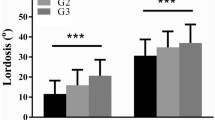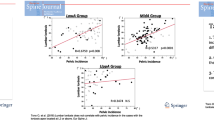Abstract
Purpose
Lumbo-pelvic sagittal alignment is affected by pelvic incidence (PI), and the PI represents the compensatory capacity of lumbo-pelvic sagittal alignment. The purpose of this study was to analyze changes in lumbo-pelvic sagittal alignment between the standing and sitting positions and to analyze its association with PI.
Methods
This study included 253 subjects (160 men and 93 women; age 53.6 ± 7.4 years). The subjects were divided into three groups (younger age group (YG), from 20 to 49 years; middle age group, from 50 to 69 years, and older age group (OG), of 70 years and above). Lumbar lordotic angle (LL), sacral slope (SS), pelvic tilt (PT), pelvic incidence (PI), and the associations between the changes in LL (∆LL), SS (∆SS), PT (∆PT), and PI were analyzed.
Results
In the YG, the amount of change in LL, SS, and PT was larger than in the OG. These parameters correlated with age in the standing position but not in the sitting position. On the other hand, in all groups, there were positive correlations between PI and changes between the standing and sitting positions. Multiple logistic regression analysis demonstrated that ∆LL = 3.81 − 0.72 × PT + 0.52 × PI, ∆SS = − 4.50 − 5.3 × PT + 0.34 × PI, and ∆PT = − 9.1 + 3.5 × PT − 0.21 × PI.
Conclusions
Change in lumbo-pelvic parameters between the sitting and standing positions correlated with PI.
Graphical abstract
These slides can be retrieved under Electronic Supplementary Material.




Similar content being viewed by others
References
Owen N (2012) Sedentary behavior: understanding and influencing adults’ prolonged sitting time. Prev Med 55:535–539
Dunstan DW, Howard B, Healy GN, Owen N (2012) Too much sitting–a health hazard. Diabetes Res Clin Pract 97:368–376
Balague F, Troussier B, Salminen JJ (1999) Non-specific low back pain in children and adolescents: risk factors. Eur Spine J 8:429–438
Aoki Y, Sugiura S, Nakagawa K, Nakajima A, Takahashi H, Ohtori S, Takahashi K, Nishikawa S (2012) Evaluation of nonspecific low back pain using a new detailed visual analogue scale for patients in motion, standing, and sitting: characterizing nonspecific low back pain in elderly patients. Pain Res Treat 2012:680496. https://doi.org/10.1155/2012/680496
Endo K, Suzuki H, Nishimura H, Tanaka H, Shishido T, Yamamoto K (2012) Sagittal lumbar and pelvic alignment in the standing and sitting positions. J Orthop Sci 17:682–686
Suzuki H, Endo K, Mizuochi J, Murata K, Nishimura H, Matsuoka Y, Tanaka H, Yamamoto K, Tateiwa T (2016) Sagittal lumbo-pelvic alignment in the sitting position of elderly persons. J Orthop Sci 21:713–717
Ochi H, Baba T, Homma Y, Matsumoto M, Nojiri H, Kaneko K (2016) Importance of the spinopelvic factors on the pelvic inclination from standing to sitting before total hip arthroplasty. Eur Spine J 25:3699–3706
Nam HS, Han M, Choi HY, Song K, Kang S, Ahn SM, Lee S-U (2018) Effect of reclining angle on lumbar lordosis at driving posture: a radiological evaluation. J Back Musculoskelet Rehabilit 31:923–930
Chevillotte T, Coudert P, Cawley D, Bouloussa H, Mazas S, Boissière L, Gille O (2018) Influence of posture on relationships between pelvic parameters and lumbar lordosis: comparison of the standing, seated, and supine positions. A preliminary study. Orthop Traumatol Surg Res 104:565–568
Roussouly P, Pinheiro-Franco JL (2011) Biomechanical analysis of the spino-pelvic organization and adaptation in pathology. Eur Spine J 20:609
Duval-Beaupere G, Marty C, Barthel F, Boiseaubert B, Boulay C, Commard MC, Coudert V, Cosson P, Descamps H, Hecquet J, Khoury N, Legaye J, Marpeau M, Montigny JP, Mouilleseaux B, Robin G, Schmitt C, Tardieu C, Tassin JL, Touzeau C (2002) Sagittal profile of the spine prominent part of the pelvis. Stud Health Technol Inform 88:47–64
Jackson RP, McManus AC (1994) Radiographic analysis of sagittal plane alignment and balance in standing volunteers and patients with low back pain matched for age, sex, and size. A prospective controlled clinical study. Spine 19:1611–1618
Legaye J, Duval-Beaupere G, Hecquet J, Marty C (1998) Pelvic incidence: a fundamental pelvic parameter for three-dimensional regulation of spinal sagittal curves. Eur Spine J 7:99–103
Suzuki H, Endo K, Sawaji Y, Matsuoka Y, Nishimura H, Takamatsu T, Murata K, Seki T, Konishi T, Aihara T, Yamamoto K (2018) Radiographic assessment of spinopelvic sagittal alignment from sitting to standing position. Spine Surg Relat Res 2:290–293
Gelb DE, Lenke LG, Bridwell KH, Blanke K, McEnery KW (1995) An analysis of sagittal spinal alignment in 100 asymptomatic middle and older aged volunteers. Spine 20:1351–1358
Mac-Thiong J-M, Labelle H, Berthonnaud E, Betz RR, Roussouly P (2007) Sagittal spinopelvic balance in normal children and adolescents. Eur Spine J 16:227–234
Roussouly P, Nnadi C (2010) Sagittal plane deformity: an overview of interpretation and management. Eur Spine J 19:1824–1836. https://doi.org/10.1007/s00586-010-1476-9
Barrey C, Jund J, Noseda O, Roussouly P (2007) Sagittal balance of the pelvis-spine complex and lumbar degenerative diseases. A comparative study about 85 cases. Eur Spine J 16:1459–1467. https://doi.org/10.1007/s00586-006-0294-6
Radcliff K, Raphael IJ, Rasouli MR, Kepler CK, Albert TJ, Parvizi J (2012) Pelvic incidence in patients with hip osteoarthritis. Spine J 12:S68–S69
Pierannunzii L (2017) Pelvic posture and kinematics in femoroacetabular impingement: a systematic review. J Orthop Traumatol 18(3):187–196
Anwar HA, Butler JS, Yarashi T, Rajakulendran K, Molloy S (2015) Segmental Pelvic Correlation (SPeC): a novel approach to understanding sagittal plane spinal alignment. Spine J 15:2518–2523
Acknowledgements
We are indebted to the Department of International Medical Communications of Tokyo Medical University for the editorial review of the English manuscript. The authors would also like to thank Ms. Yuri Amamizu of the Department of Orthopedic Surgery for assistance in preparing the initial English manuscript. No benefits in any form have been received or will be received from any commercial party associated directly or indirectly with this study.
Author information
Authors and Affiliations
Corresponding author
Ethics declarations
Conflict of interest
The authors declare that they have no conflict of interest.
Ethical approval
This study was approved by the institutional review board of our institution.
Informed consent
All subjects provided written informed consent after explanation of the experimental protocol.
Electronic supplementary material
Below is the link to the electronic supplementary material.
Rights and permissions
About this article
Cite this article
Maekawa, A., Endo, K., Suzuki, H. et al. Impact of pelvic incidence on change in lumbo-pelvic sagittal alignment between sitting and standing positions. Eur Spine J 28, 1914–1919 (2019). https://doi.org/10.1007/s00586-019-05891-9
Received:
Revised:
Accepted:
Published:
Issue Date:
DOI: https://doi.org/10.1007/s00586-019-05891-9




